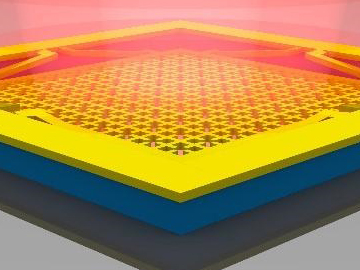
Artist's conception of the room-temperature MEMS metamaterial, which can achieve reconfigurable infrared intensities equivalent to a temperature change of nearly 20 °C. [Image: Xinyu Liu, Duke University]
Whether it's Earth Day or any day, recycling is generally better for the environment than wasting. Now, researchers at a U.S. university have developed a fully controllable, metamaterial-based thermal emitter that could allow for the harvesting of waste heat (Optica, doi:10.1364/OPTICA.4.000430).
Tailoring energy with MEMS
The microelectricalmechanical-system (MEMS) device, built by Duke University, USA, engineering professor and OSA Fellow Willie Padilla, as well as doctoral candidate Xinyu Liu, consists of a tessellated metamaterial layer suspended by eight cantilever arms above a metal slab coated with dielectric aluminum oxide. The top layer was made of a gold-germanium-gold sandwich, with openings that look like tiny crosses made of squares. The pattern repeats every 4.6 μm.
Applying a voltage to the structure brings the top layer comes in contact with the slab; the cantilever arms provide the restoring force. The bias-on configuration causes the device to absorb photons and emit infrared radiation at a wavelength near 9 μm. According to the authors, the emitter can be modulated at up to 110 kHz.
Scaling across the spectrum
The MEMS device operates at room temperature, but thermal camera images showed that it could change its emitted radiation over the equivalent of a nearly 20 °C temperature change. The team built another device of 8 x 8 pixels, with each of these MEMS emitters constituting one pixel, and showed that it could create an infrared image at room temperature.
The authors suggest that the emitter could have numerous applications, including combatant identification—and camouflage—on the nighttime battlefield.
